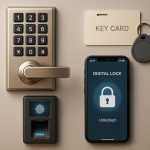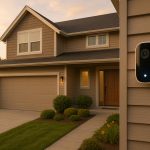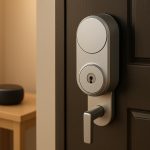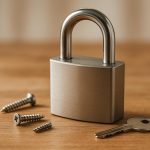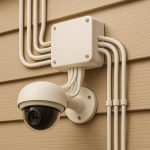Deciding between deadbolts and smart locks in 2025 comes down to your priorities: simplicity and reliability or convenience and modern features.
- Deadbolts: Reliable, durable, and low-maintenance. They don’t need power or internet and offer strong physical security, especially with Grade 1 models. Ideal for those who prefer straightforward solutions without ongoing upkeep.
- Smart Locks: Offer convenience with remote access, biometric options, and integration with smart home systems. They track usage, send alerts, and eliminate the need for physical keys. However, they require batteries, updates, and are vulnerable to cyber risks.
Quick Overview:
- Deadbolts are best for physical strength and long-term reliability.
- Smart locks excel in convenience, remote control, and integration with other devices.
Choosing the right lock depends on your lifestyle, budget, and security needs. Below, we’ll break down the strengths, weaknesses, and factors to consider for both options.
Ask Mr. Locksmith: Mechanical Deadbolt vs Electronic Deadbolt?
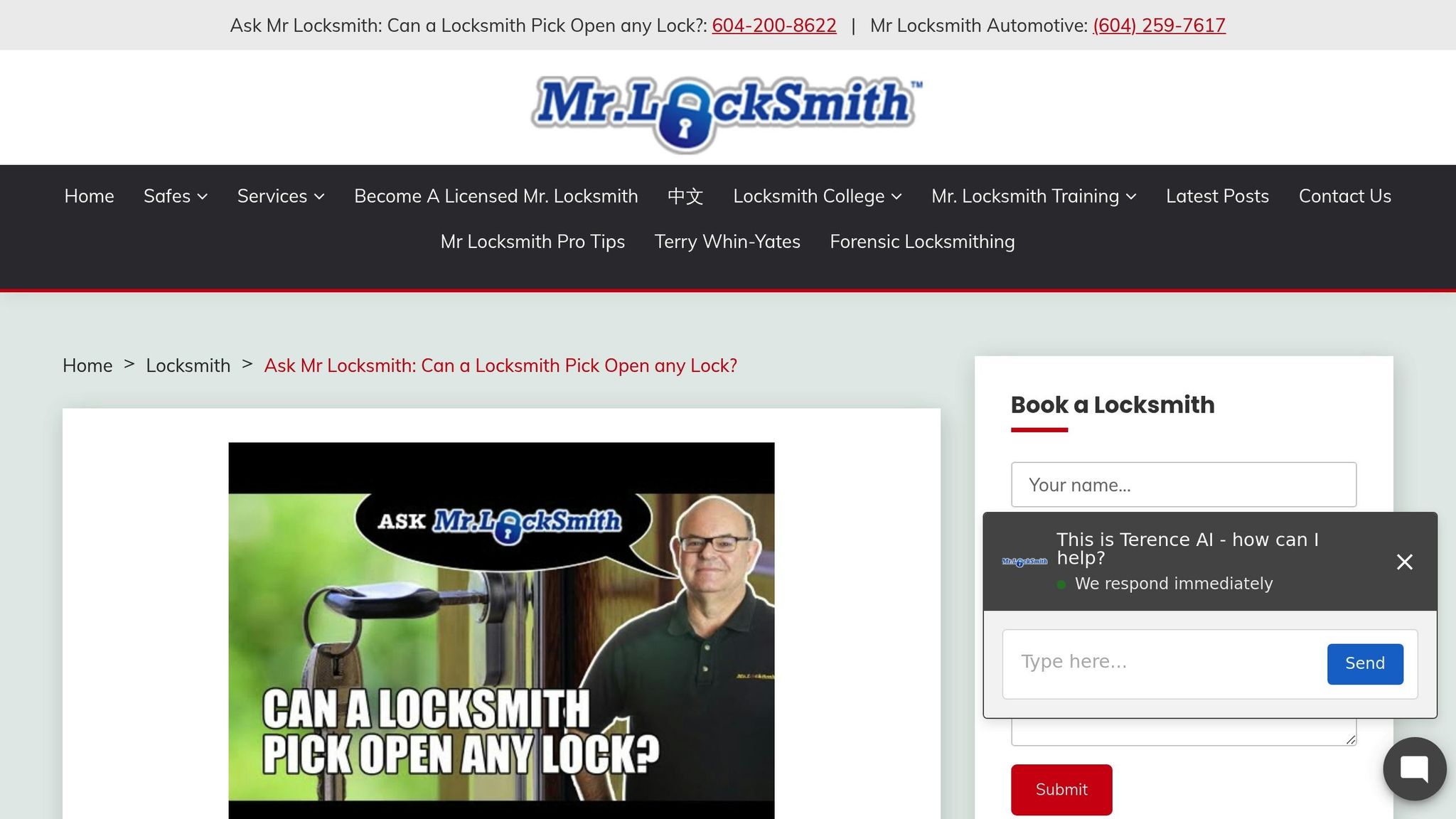
Deadbolt Locks: Security and Reliability
Deadbolt locks provide dependable security without relying on electricity or advanced technology. Their basic mechanical design ensures solid protection, making them a trusted choice for safeguarding property.
Physical Strength and Durability
Deadbolts are built with solid metal bolts and reinforced strike plates, creating a strong barrier against forced entry. Grade 1 deadbolts, which meet strict industry standards, are specifically designed to resist break-ins. When paired with a reinforced strike plate, the bolt securely locks into the door frame, offering enhanced protection.
Top-tier deadbolts feature hardened steel bolts, corrosion-resistant housings, and anti-drill components to resist picking and drilling attempts. These locks are engineered to withstand extreme temperatures and harsh weather, ensuring consistent performance and minimal wear. This durability not only boosts security but also reduces maintenance efforts over time.
Low Maintenance Requirements
One of the key advantages of deadbolts is their low maintenance. Since they don’t rely on batteries or electronic components, they avoid issues like software malfunctions, battery failures, or connectivity disruptions common in digital locks. A simple application of lubricant from time to time keeps the mechanism operating smoothly.
Deadbolts are also budget-friendly, both in terms of purchase price and maintenance. Their straightforward design makes it easy and inexpensive to duplicate keys, ensuring quick access to replacements without the complexities of electronic systems.
Professional Installation and Repairs
Deadbolts are designed for efficient installation and repair by professionals. Services like those offered by Sherlock’s Locksmith ensure proper alignment and door reinforcement, maximizing the lock’s security potential.
Accurate cylinder alignment not only guarantees smooth operation but also extends the lifespan of the lock. When repairs are needed, the mechanical simplicity of deadbolts allows professionals to troubleshoot and resolve common issues, such as binding or cylinder wear, with basic cleaning, lubrication, or part replacement – avoiding the need for a full lock replacement.
Sherlock’s Locksmith also provides upgrades for existing deadbolt systems. These enhancements, including longer bolts, stronger strike plates, and improved cylinder designs, allow property owners to gradually increase their security as their needs change.
Smart Locks: Features and Technology
Smart locks bring a new level of convenience and security to homes by combining advanced technology with everyday functionality. With features like smartphone apps, biometric access, and integration with other smart devices, these locks simplify how we secure our homes while offering detailed monitoring and real-time alerts.
Digital Security Features
Smart locks provide a range of digital tools that go beyond traditional locks. Biometric access, such as fingerprint recognition, removes the need for physical keys, making it harder for unauthorized individuals to gain entry. If someone attempts to tamper with the lock, instant alerts can be sent directly to your smartphone, keeping you informed no matter where you are.
Another standout feature is activity logs, which track who enters and exits, complete with timestamps and user IDs. This creates a clear record of access – perfect for households with multiple users. Additionally, auto-locking features ensure your door locks itself after a set time, solving the all-too-common problem of leaving doors unlocked.
Smart locks also shine when it comes to remote management. With temporary access codes, you can grant secure, time-limited access to guests or service providers without needing to be present. This is particularly helpful when paired with remote monitoring capabilities.
It’s worth noting that 28% of Americans misplace their keys at least once a week, and 21.5% spend over 15 minutes searching for them. By eliminating the need for physical keys, smart locks address this everyday frustration.
Smart Home System Integration
Beyond security, smart locks excel in creating a connected home experience. They integrate smoothly with major smart home platforms like Amazon Alexa, Google Home, Apple HomeKit, and Samsung SmartThings. Using technologies like Wi-Fi, Bluetooth, Z-Wave, and Thread, these locks can easily communicate with other smart devices.
This integration opens up a world of possibilities. For instance, you can set up automated routines – like locking your door and turning off lights with a single voice command. Hands-free operation becomes a breeze with voice control through smart speakers, especially when your hands are full.
Smart locks also work seamlessly with video doorbells, boosting security. With 71% of U.S. adults concerned about package theft, these connected systems let you monitor deliveries and grant access remotely, ensuring your packages stay safe.
Looking ahead, the adoption of Matter and Thread standards in 2025 promises even better compatibility and security. These standards make it easier for smart locks to communicate with devices from various brands, giving homeowners more flexibility and peace of mind when building their smart home ecosystems.
sbb-itb-643e28e
Security Comparison: Deadbolts vs Smart Locks
When deciding between deadbolts and smart locks, it’s important to weigh how each performs across key security aspects. Deadbolts are known for their mechanical strength, while smart locks bring the added convenience of digital technology. Understanding these differences can help you choose what fits your needs best.
Comparison Factors
Physical Security Strength is where deadbolts shine. Their solid metal construction and thick steel bolt create a strong physical barrier, making them tough to breach through brute force. Smart locks, though they often use similar deadbolt mechanisms, incorporate electronic components that can introduce additional vulnerabilities.
Break-in Resistance highlights another key difference. Deadbolts are vulnerable to traditional methods like lock picking, bumping, or drilling, which require physical presence and skill. Smart locks, however, must defend against both physical and cyber threats, such as hacking, signal interference, or electronic tampering. Many smart locks in 2025 now include anti-tampering alerts to notify homeowners of potential breaches.
User Convenience is where smart locks take the lead. Deadbolts rely solely on physical keys, which can be lost or duplicated. Smart locks, on the other hand, offer multiple access methods, such as smartphone apps, keypads, biometric scanners, and even backup physical keys. Features like remote access and real-time monitoring make them particularly appealing for modern security needs.
| Factor | Deadbolt Locks | Smart Locks |
|---|---|---|
| Physical Durability | Excellent – solid metal construction | Good – electronic components add complexity |
| Power Requirements | None | Requires battery or hardwired power |
| Maintenance Needs | Minimal – occasional lubrication | Regular – battery changes, software updates |
| Installation Complexity | Simple – standard door preparation | Moderate – may need wiring or setup |
| Weather Resistance | Excellent – no electronics to fail | Good – modern models are weatherproof |
| Remote Access | None | Full smartphone control and monitoring |
| Access Tracking | None | Logs with timestamps available |
| Vulnerability Types | Physical attacks only | Both physical and cyber threats |
| Professional Service | Rekeying or lock repairs | Technical support and updates |
Compatibility with Security Systems is another area where smart locks stand out. While deadbolts operate independently, smart locks integrate seamlessly with broader security systems, offering features like remote monitoring and automated locking.
Long-term Reliability differs significantly. Deadbolts can last for decades with minimal upkeep, requiring only occasional lubrication. Smart locks, however, need regular battery replacements, software updates, and may eventually require hardware upgrades as technology advances. That said, smart locks offer real-time updates, such as low-battery alerts, helping to prevent unexpected issues.
Cost Implications extend beyond the initial purchase. Deadbolts have minimal ongoing expenses but may incur locksmith fees for rekeying or repairs. Smart locks, while eliminating costs related to lost keys or emergency lockouts, may involve recurring expenses like battery replacements or subscription fees for advanced features.
The learning curve is another consideration. Deadbolts are straightforward and require no technical knowledge. Smart locks, however, demand familiarity with apps, Wi-Fi setups, and troubleshooting electronic issues, which can be daunting for less tech-savvy users.
In Emergency Situations, deadbolts are reliable, functioning without power or network connectivity. Smart locks typically include backup power options and mechanical key overrides, but these features add complexity and could fail during critical moments when access is most needed.
Choosing the Right Lock Type
When deciding between deadbolts and smart locks, your choice will largely depend on your lifestyle, security needs, and comfort with technology. Factors like your neighborhood’s safety, how often you travel, and your budget will play a big role in determining the best option for you.
Budget considerations are a key factor. Deadbolts are generally more affordable, with prices ranging from $50 to $200, and they come with minimal ongoing costs – mainly occasional maintenance. On the other hand, smart locks start at around $150 and can go beyond $400 for high-end models. They also come with recurring expenses, such as battery replacements every 6-12 months and, in some cases, subscription fees for features like cloud storage.
Lifestyle factors also weigh heavily in the decision. If you’re frequently away from home, struggle with keeping track of keys, or manage rental properties, smart locks bring convenience with features like remote access and activity tracking. However, if you prefer a simple, no-frills solution and don’t need remote control, deadbolts provide reliable security without the added complexity of technology.
Neighborhood security needs should guide your decision as well. In high-crime areas, the sturdy physical protection of Grade 1 deadbolts might be the better choice. Meanwhile, smart locks can be particularly useful in suburban areas where deliveries and service providers are common, thanks to their temporary access codes and delivery notifications.
The following sections dive deeper into these considerations.
Installation and Compatibility
Door compatibility plays a crucial role in choosing a lock. Deadbolts fit most standard doors with a 2-1/8-inch hole, making them easy to install. Smart locks also use the same hole size but may require extra space for additional components.
Another consideration is how the lock integrates with other security systems. Deadbolts operate independently and don’t connect to alarm systems or smart home platforms. In contrast, smart locks can integrate with systems like Ring Alarm, ADT, or SimpliSafe, creating a more connected and responsive security setup. If you already use smart home devices, a compatible smart lock can streamline your home’s security.
Installation requirements vary between the two types. Deadbolts are straightforward to install, typically taking 30-60 minutes with basic tools. Installing a smart lock can be more complex, often involving Wi-Fi setup, app configuration, and possibly low-voltage wiring for hardwired models. While many smart locks are DIY-friendly, older doors or complicated setups might require professional assistance.
Retrofitting challenges are more common with smart locks, especially on older doors with non-standard hole sizes, metal doors, or doors with existing mortise locks. Deadbolts, on the other hand, are designed to fit standard dimensions that have remained consistent over decades.
Weather Resistance and Long-Term Performance
The durability of your lock can depend heavily on your local climate. Deadbolts are built to withstand temperature swings and resist moisture, salt air, and other environmental factors, making them a solid choice for homes in coastal or mountainous areas. Smart locks, while weather-resistant, come with electronic components that are more vulnerable to extreme conditions.
Smart locks usually carry IP65 or IP66 ratings, meaning they’re resistant to dust and water jets. However, extreme cold can reduce battery life by 30-50%. In areas where temperatures drop below 0°F, batteries may drain faster, requiring frequent replacements during winter.
Humidity and moisture affect each lock type differently. Deadbolts may develop some rust over time, but this rarely impacts their functionality. Smart locks, however, rely on sealed electronics that can fail if moisture infiltrates. While they’re designed with weatherproof gaskets and sealed battery compartments, these protections can degrade after 5-7 years.
Long-term durability is another factor to consider. With proper maintenance, deadbolts can last 20-30 years, requiring only occasional lubrication and rekeying. Smart locks, however, have a shorter lifespan of 5-10 years due to battery wear, software updates, or potential electronic failures. On the plus side, many smart locks receive regular software updates that enhance their features and security.
Maintenance needs are different for each type. Deadbolts require lubrication every 6-12 months and occasional cleaning, which takes just a few minutes. Smart locks, on the other hand, need regular battery replacements (2-4 times a year, depending on usage and weather), software updates, and periodic cleaning of keypads or sensors.
Privacy and Cybersecurity Concerns
Modern locks, particularly smart ones, introduce unique privacy and security challenges. Data collection is a key concern with smart locks, as they log entry events, access codes, and sometimes even location data. While this data can improve functionality, it may raise privacy concerns for users uncomfortable with their routines being digitally tracked.
Hacking risks are another issue exclusive to smart locks. Since they connect to home Wi-Fi networks, they can become entry points for cybercriminals. Weak passwords, outdated firmware, or unsecured networks can lead to unauthorized access – not just to the lock, but to other connected devices in your home. Reputable manufacturers address these vulnerabilities through regular security updates.
Network security requirements add another layer of complexity. To secure a smart lock, you’ll need strong Wi-Fi passwords, updated router firmware, and, ideally, a separate network for IoT devices. Security experts often recommend setting up a dedicated guest network for smart devices to isolate them from personal computers and phones.
Emergency access is a critical consideration. Deadbolts are unaffected by power outages or internet disruptions, providing reliable access at all times. Smart locks usually include backup mechanical keys, but these can be lost or duplicated. Some models offer backup power options, like external battery packs, but these add complexity and potential failure points.
User access management is where smart locks shine, offering advanced control options. Unlike deadbolts, which require physical keys and professional rekeying, smart locks allow you to change access codes instantly, create temporary codes for guests, and monitor detailed access logs. However, this convenience comes with the need for ongoing digital management and the risk of compromised accounts or shared access codes.
Making the Right Choice for 2025
Now that we’ve explored the security options, it’s time to decide which lock suits your needs for 2025. Your decision should hinge on three key factors: security, budget, and lifestyle.
Traditional deadbolts are all about simplicity and dependability. They offer solid physical security and require little upkeep – just the occasional lubrication to keep things running smoothly. Since they don’t rely on power or internet connectivity, they’re free from the risks of outages or tech failures.
On the other hand, smart locks bring convenience front and center. While they come with a higher initial price tag and need periodic battery changes and software updates, they save you from the hassle and expense of rekeying when keys are lost. Plus, they make managing temporary access a breeze, which is a big win for rental properties or busy households.
To make the best choice, assess your home’s specific security needs. If you’re in an area with a higher risk of break-ins, a sturdy traditional deadbolt – unaffected by power outages – might be the safer bet. But if you value features like remote access or need to grant temporary entry, a smart lock could be the better option. A professional locksmith can also help evaluate your doors’ condition and alignment to ensure your chosen lock works seamlessly.
Some homeowners find a middle ground by using smart locks on main entrances for convenience and traditional deadbolts on secondary doors for added peace of mind. This combination lets you enjoy modern features without sacrificing the reliability of tried-and-true security.
Think long-term as you decide. If you’re planning to upgrade your home’s tech or manage rental properties, smart locks might align better with your goals. But if you prefer a low-maintenance, dependable solution that can last for decades, traditional deadbolts are a solid choice that has stood the test of time.
FAQs
How do smart locks protect against hacking, and what can homeowners do to improve their security?
Smart locks are built with robust security measures to guard against hacking, often relying on advanced encryption standards like AES-128 or AES-256 to protect data. Many models also come equipped with features such as tamper alerts and real-time activity logs, helping homeowners stay informed about any unusual activity.
To keep your smart lock secure, consider these best practices:
- Keep the firmware up to date: Regular updates address potential security flaws and improve protection.
- Create strong, unique passwords: Avoid reusing passwords across multiple devices to minimize risks.
- Enable two-factor authentication (2FA): This adds an extra layer of security by requiring a second verification step.
- Opt for trusted brands: Choose locks from manufacturers known for their commitment to cybersecurity.
Taking these precautions can help ensure your smart lock remains a reliable and secure part of your home in 2025.
What should I consider when deciding between a deadbolt and a smart lock for long-term reliability and maintenance?
When considering long-term reliability and maintenance, deadbolts stand out as the simpler option. Their purely mechanical design means they’re low-maintenance and built to last, often functioning reliably for decades without significant issues.
Smart locks, however, come with a different set of considerations. They depend on electronic components, batteries, and software, which introduces some upkeep. Batteries typically need replacing every 6–12 months, and there’s always the possibility of software bugs or connectivity issues. Plus, as technology evolves, smart locks might require upgrades or replacements every few years to keep up with newer systems.
If your priority is minimal maintenance and long-term durability, deadbolts are a dependable choice. But if you’re drawn to modern conveniences like remote access and smart home integration, a smart lock might be worth the additional effort.
Can smart locks work with my current home security system, and what are the advantages of connecting them?
Smart locks can often be connected to your existing home security system, bringing added convenience and functionality. When integrated, they offer features like remote access, so you can lock or unlock your doors no matter where you are, and real-time alerts, notifying you of any tampering or unauthorized access attempts. Many systems also include automation options, such as locking your doors automatically at a specific time or syncing with your security system when it’s armed.
This kind of setup blends physical security with modern technology, making your home safer and your routines easier. For instance, you can grant temporary access to guests or service providers remotely, without needing to be there in person. It’s a practical way to stay in control of your home security while streamlining everyday tasks.



